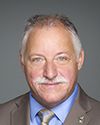Madam Speaker, as always, it is an honour to be able to enter into debate and discussion regarding the important matters facing Canadians and to participate in the debate on Bill C-23, the historic places of Canada act.
Many Canadians would consider our national parks and our national historic sites to be truly jewels of our country. When we speak to folks from around the world, often when they are asked what comes to mind when they think of Canada, there are many things, from freedom to our history. However, certainly associated in those first few remarks, I have so often heard the conversation go to things like our national parks, some of our national historic sites and even the green roofs of our Parliament buildings, although they are not necessarily so green, given that they were replaced more recently and the copper housing has not quite gotten there yet.
So often, it is about the history, the places, the events, the locations, the buildings and the monuments, whether that be a monument that has been built to remember something or one of those more intangible monuments, which I will get into closer to the end of my speech. There are many examples that exist across my constituency of those monuments that speak to our nation's history.
As we enter into the specifics of what Bill C-23 is about, it updates and modifies the Historic Sites and Monuments Board of Canada to ensure that something very important happens. That is to fulfill call to action 79 in the truth and reconciliation report, to include indigenous representation in the national historic sites conversation, not just the board itself, but more importantly the entire conversation surrounding what this means.
We have heard references to this already this morning and, I am sure, we will over the course of the debate. I am hopeful, as this bill works its way through Parliament, that there is going to be a whole host of conversations that include the broad width of what Canadian history is. That includes the good, the bad and the ugly, to ensure that we have those honest conversations.
It is not about erasing history. I want to make that very clear. It is not about erasing parts of our past. It is not even about tearing down statues. It is about ensuring that we have a holistic and realistic conversation about what our history is.
We see numerous examples of where we have things in our country's past, both post-Confederation and pre-Confederation, where there is a lot that we can be very proud of as Canadians. Then there are things that we should pause and reflect on, serious mistakes that have been made. My hope is, as we talk about the conversation around national monuments, around historic places and the designations, specifically when it comes to those owned by the federal government, as is set out in the bill, that we can have that realistic and holistic conversation about what that looks like.
When it gets into some of the specifics of what this bill is about, I would emphasize that we have to get it right. One of the concerns, certainly, that I have highlighted before in this place, and one that I suspect will be expanded on in further debate, is that this bill would give expansive powers to the executive branch of government, specifically the minister. I hope members will forgive me for being a little hesitant to grant powers, and wide-reaching and expansive powers, to the minister, in this case the Minister of Environment, who has not necessarily demonstrated that he can be trusted to ensure that those powers will be respect over the course of his mandate.
The reason I bring this up, as it is very important and I hope the members opposite will note this importance, is that we live in a democracy. The reality of a democracy is that, when a bill is passed, it not only applies to the current government, but it also applies to how future governments operate.
My encouragement to the members opposite would be, as we look through some of the dynamics associated with the quite broad powers that are not clearly defined in this bill, and as we look to amendments to the bill at committee, to make sure we tighten those up and we get it right. We need to do what is required so that we get the reconciliation question right. We need to ensure that, when it comes to the powers, if any, granted to the executive branch of government, there are the appropriate limitations on that power.
I will pose a question somewhat rhetorically at this point, although I am sure it will be asked more specifically as the debate goes on. I hope it is not a long time until there is a Conservative government that sits on the government side of this place. My encouragement to Liberal members would be make sure that, when they grant far-reaching powers to a minister of the Crown without appropriate safeguards and checks on that power, to acknowledge that one day they will not be in power. One day there will be a minister in power whom they may have ideological, political and other disagreements with.
As we look at the powers we are granting to a minister of the Crown, the executive branch of government, we need to ensure that we get it right and that there are appropriate safeguards. As was brought up in a question earlier, we need to look at the fact that there are broad-sweeping powers in terms of search, seizure and sale. This is specifically limited to, as outlined in the bill currently, the areas that are owned by the federal government in terms of national parks and historic places. However, it gets very grey as we have hundreds of thousands of Canadians who live in national parks over the breadth of our country.
Further, there is the possibility that, without our getting those definitions and frameworks absolutely correct, we could see these powers expanded. The last thing we want to do in this place is to erode the rights and freedoms of Canadians. Unfortunately, I do not have a lot of trust that the government will ensure those powers are only exercised in a manner that respects Canadians.
I would like to highlight something when it comes to enforcement. Enforcement, of course, is the other side of powers being given. There has to be an enforcement mechanism. Specifically, we are seeing, in this bill, that park wardens and the associated administration structures within parks, like game wardens, local police or whomever, could have significant authority to enforce aspects of this act.
I would specifically note one element that is somewhat problematic. I bring this up because the minister has shown an ideologically driven force to reshape the economy of Canada. The last thing I would want in a bill related to an important issue, like reconciliation, would be for Canada's national parks and historic sites to all of a sudden become a pawn to the whims of an activist who holds an office.
The reason I bring that up is that the minister made it very clear in his political life, before and after being elected, that he is very intent on reshaping a significant aspect of Canada's economy, which is specifically shutting down oil and gas. This bill has specific mechanisms that would give the minister wide-sweeping powers related to navigable waters and to the ability for mooring to take place.
I would urge caution, and I think I have made it very clear that I do not have a lot of trust in the Minister of Environment and Climate Change. However, I would encourage members opposite to look in the mirror and ask whether they would trust a government with a different political persuasion with those powers.
I believe that would provide the context required to ensure that we narrow the scope and get the definitions right to ensure that when this bill comes out of committee, hopefully the appropriate context would be given when any new powers are offered. The Conservatives will certainly be hard at work being collaborative in every way possible to get those definitions and guardrails right.
As we debate the context surrounding this, I could not help but think, as I was planning my speech, that there are a few important aspects that I would like to bring closer to home, if the Speaker will indulge me.
It has been interesting. I would suggest that we do not always do a great job of teaching Canadian history and the full breadth of what that history is. I am most of the way through a book called “The Cowboy Cavalry: The Story of the Rocky Mountain Rangers”. Colter Wall is the son of a friend of mine, a friend who, I will note, recently had his portrait hung up in the Saskatchewan legislation. He is former premier Brad Wall, a great Canadian patriot and leader in the province of Saskatchewan. His son, Colter Wall, is a country and western singer who published a song a couple of years ago about the Rocky Mountain Rangers.
As westerns have re-emerged in popularity in Hollywood, it is incredible, as we look through much of our nation's history, specifically that of the Prairies, that we have so much rich history. Not all of it is positive, but there are so many stories about the lives of people. I think of John Ware, the Black cowboy. I ask members to imagine the context of a Black cowboy 140 years ago in the Prairies, when he would have been likely one of the only people of colour in those communities. There are the the stories, and in some cases the legends, and there have been some incredible legends about the story of John Ware in our western heritage.
I think about the Neutral Hills, which are just north in my own constituency. In fact, I can see it from my deck, and they have significant indigenous history. This is neither a federally owned historic site, nor a national park, and it is something that most folks in this place have probably never even heard of. However, according to legend, Neutral Hills is a place where many indigenous tribes, when they were warring about different hunting grounds and whatnot, listened to the great spirit Manitou, and from the infinite wisdom they heard, they acknowledged that there needed to be a place of peace, so about six or eight miles north of where I live there is what is referred to as the Neutral Hills. It is a beautiful Prairie landscape where we can still find teepee rooms and burial sites. If we look hard enough we can find arrowheads and other pieces of our indigenous history there, but that is the richness that exists.
If we drive across the Prairies and take some back roads we will see cairns that mark some indigenous settlements past of our nation's history. In many cases, we cannot even find any further details on the Internet, other than that brass plaque and concrete cairn.
I think of the legend of Blood Indian Creek. When the band of the Saulteaux first nation had come west from the Lake of the Woods in about 1840, and there was a raiding party of Blackfeet. Some wars and battles followed, and they came to what is now a municipal park, Blood Indian Park.
Some significant history and some indigenous history and wars that played a significant role in forming our nation's history are significantly impacted.
We can think about some of the settlers and explorers that we often hear about. For example, there is Anthony Henday. We have so much of that rich history, with many elements of what that looks like and how formative it was. Now, I am speaking from the expertise of a westerner, and my colleague from the Liberal Party who spoke earlier referenced his expertise in the Lower Mainland.
I have visited the Fort Langley National Historic Site and saw some of the incredible history that is remembered there, and there are other places in the country as well. There are highways now named after Anthony Henday, but few Canadians know about the expedition that took place and the stories associated with his role in the Hudson Bay Company.
There was the Palliser expedition, and I have mentioned that I live in the north part of Palliser's triangle. There was an expedition to see, as the buffalo population declined on the plains, that it was prepared for settlement. There is a complicated history associated with that, and we see the impacts of aspects of that history there today.
I would further acknowledge the Viking rib stones, which has a sign on the side of the highway that most people in my constituency drive by, probably not paying too much attention. Interestingly, it has become an important local place for the advancement of reconciliation.
Also, the Royal Alberta Museum worked very hard to bring back the Iron Creek meteorite. It is a meteorite made of iron that sits on top of a hill, which has historical and spiritual significance for local indigenous peoples. It is called “Manitou Asinîy”.
I also represent the Drumheller Valley, and we have a national historic site there in the Atlas Coal Mine, as well as other indigenous history. I have spoken with those who have had tremendous success in highlighting some of those things, many of which are not places on a map necessarily. They are not defined as something that would be as well known as a fort location or a national park. However, there are significant historic places and events that have shaped our nation's history.
If I were to canvas this place on Drumheller, they would think of the Royal Tyrrell Museum, Joseph Burr Tyrrell's namesake, as well as the discovery of many dinosaurs. However, although Drumheller is often associated with ancient and prehistoric history, it is also full of indigenous history. For example, many folks who have driven on the highway through central Alberta would likely have stopped to see the hoodoos, and there is indigenous significance associated with them.
To conclude, we have to get these things right with Bill C-23, which is the reason I highlighted some of the local, historically significant things I am proud to represent. I would also mention Dry Island Buffalo Jump Provincial Park as another example of some of that rich indigenous history. The conversation around history is so very important, which is why I implore every member of the House to get it right. The legislation before us could not only have an impact on historic sites in this country and the ability for reconciliation to go forward, but also set a precedent in the possibility of wide-sweeping powers.
I encourage all members of this place work diligently to make sure that we strike the right balance, pursue that path of reconciliation, and have the honest conversations about Canadian history that are so very essential to ensure that we do not forget about the past and the lessons that were learned and that we can continue building a country we can be proud of.






